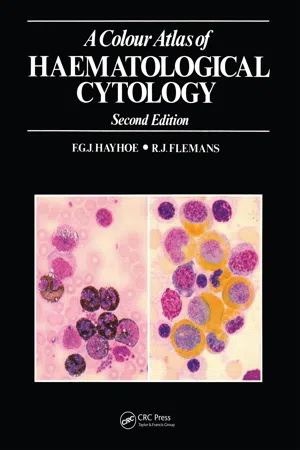
A Colour Atlas of Haematological Cytology
F.G.J. Hayhoe, R.J. Flemans
- 240 pagine
- English
- ePUB (disponibile sull'app)
- Disponibile su iOS e Android
A Colour Atlas of Haematological Cytology
F.G.J. Hayhoe, R.J. Flemans
Informazioni sul libro
The second edition of this atlas has been revised and greatly en-larged to take account of recent diagnostic advances in the field of haematology. It contains 750 color photomicrographs of common and less common cell types, and is intended to supplement the per-sonal study of preparations under the microscope.The photographs are grouped into five sections covering red cells and their precursors; nonerythroid cells of myeloid origin; lympho-cytes, plasma cells and their derivatives and precursors; miscella-neous cells of blood and marrow, including foreign cells and para-sites; and the imprint cytology of lymph nodes and spleen. Each section is preceded by a brief introduction, and an appendix pro-vides technical details of staining methods. The text accompanying the illustrations serves chiefly to identify the cells, but also gives explanations of certain unusual appearances and the cytochemical reactions where necessary.A Colour Atlas of Haematological Cytology will be useful to students of medicine and medical laboratory science, as well as to doctors and technicians specializing in the diagnosis of haematological disease.
Domande frequenti
Informazioni
Part 1
The red cells and their precursors
- (1) The basophilic or early erythroblast, or normo-blast A
- (2) The polychromatic or intermediate erythroblast, or normoblast B
- (3) The orthochromatic or late erythroblast, or normoblast, or normoblast C.